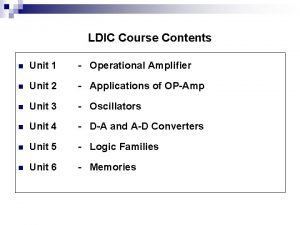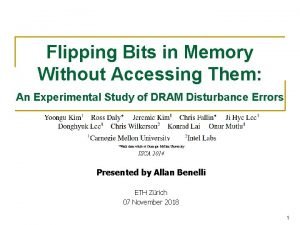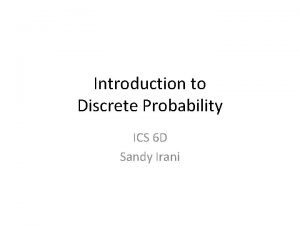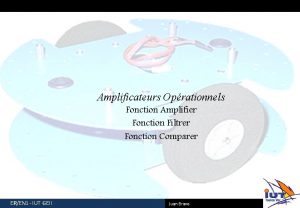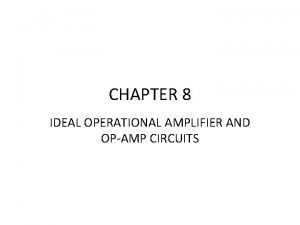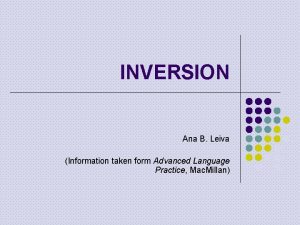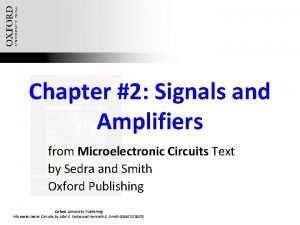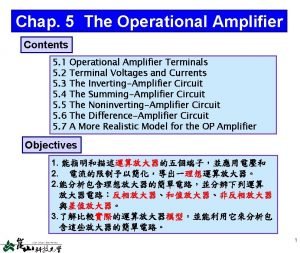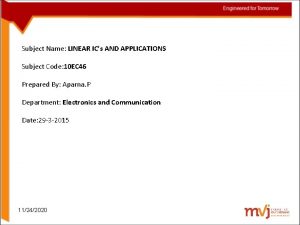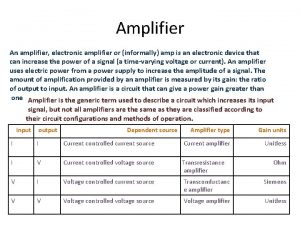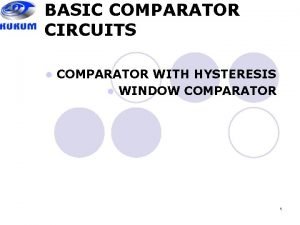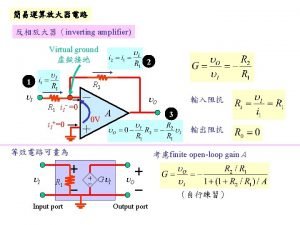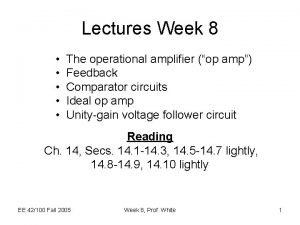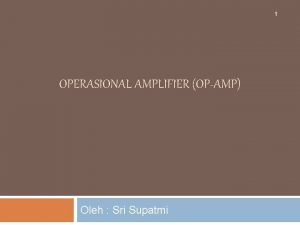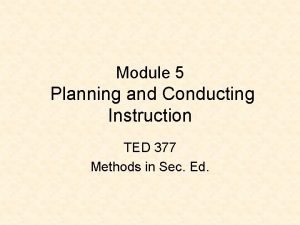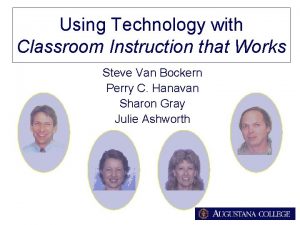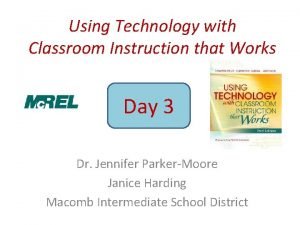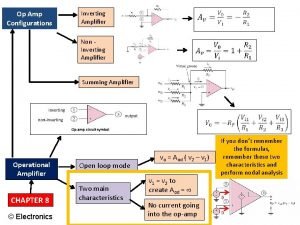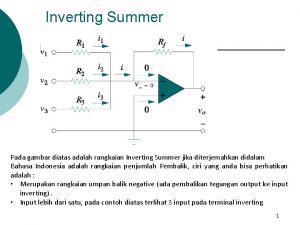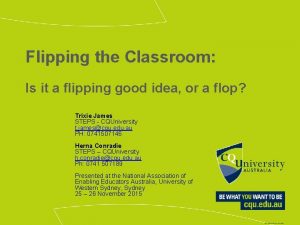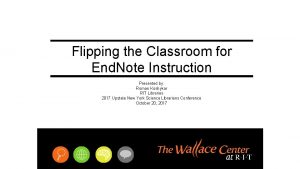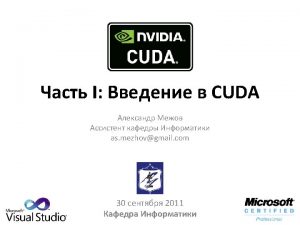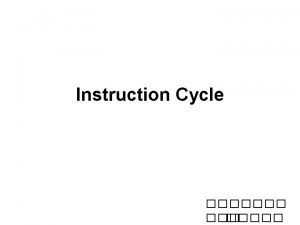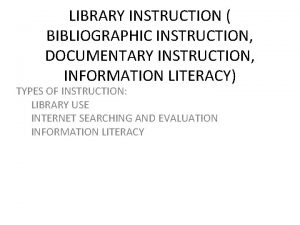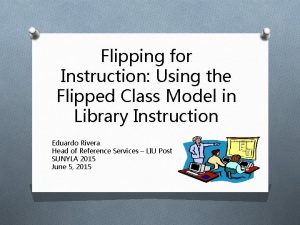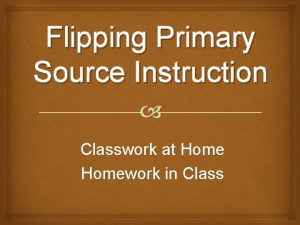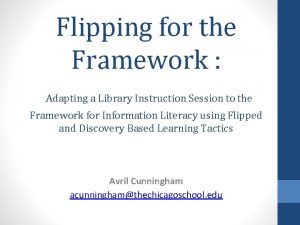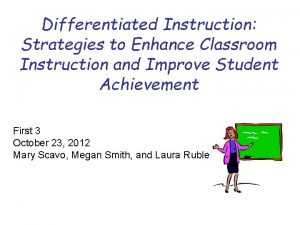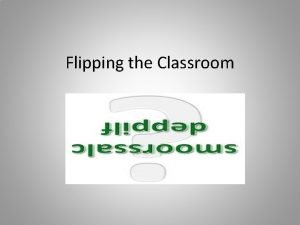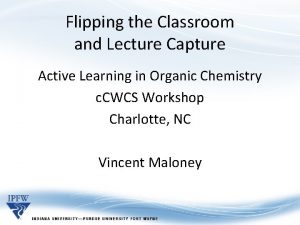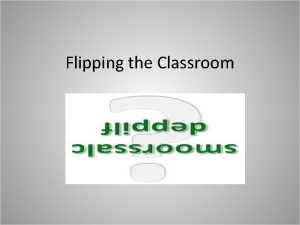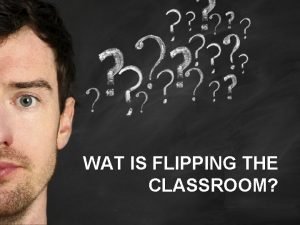Flipping the Classroom The concept of Inverting Instruction























- Slides: 23

Flipping the Classroom. The concept of Inverting Instruction Cliff Zyskowski & Julie Hall Napa Valley College Flex Day 2012 http: //youtu. be/Gxd_u. BUxy. MA

Flipping the Classroom Agenda • Ice breaker • Sage on the Stage vs. Guide on the Side revisited • Active learning defined • Bloom’s Taxonomy • Constructivist vs. Cognitivist Learning • Experiential & Transformative Learning • Obstacles and ways to overcome them • Think- pair- share, Clicker fun & Voice. Thread • Assessment • “final survey says”……. .

icebreaker • Snowball • Class motto for the semester “quotation” • Theme for the day’s lesson plan

Sage on the Stage!

Sage vs. Guide • Latest in brain research • Talking=learning • Average student’s attention span 10 minutes • Transformation • Passive to active learners through studentcentered vs. instructor-centered focused content & activities • Research shows: discussion over lecture • Leads to higher-level critical thinking & learning (Mc. Keachie, 1986; Paul & Elder, 2006). • Re-invent yourself! Be a facilitator of learning vs. the ultimate expert or Sage!

New Term for “Guide by Your Side”“Meddler in the Middle” • Role of the student-centered instructor must shift to be more like a “Meddler-in-the middle [who] positions the teacher and student as mutually involved in assembling and dis-assembling cultural products” (Mc. William, 2008, p. 1). • The Meddler-in-the middle instructor takes more risk and is free to make errors as he or she learns along with the students!

Inverted or Flipped Classroom

Active Learning Defined • Involvement = activities • More student skill development; less information transmission • Exploration of attitudes and values • Increase in student motivation • Immediate instructor feedback and enhanced teaching presence • Higher order thinking: analysis, synthesis, evaluation http: //www. youtube. com/watch? v=Us. DI 6 h. Dx 5 u. I


Constructivist vs. Cognitivist Approach to Instruction “Constructivist instructors encourage students to constantly assess how the activity is helping them gain understanding. Through the process of questioning, students learn the strategies that help them become expert learners. The process of active learning gives students the ever-broadening skill of lifelong learning” (All and Brandon, 2010, p. 1). Vs.

Kolb’s Experiential Learning & Mezirow’s Transformative Learning • Kolb (1984)- learning as the process whereby knowledge is created through the transformation of learning in a specific learning environment. • Kolb’s philosophy aligns with Mezirow’s (1991) transformative learning theory as students are transformed by their learning and ready to apply skills directly in the workplace.

Kolb- Learning from Experience Requires Four Abilities: 1. An ability to experience real-world experiences 2. The ability to view the experience from multiple perspectives 3. The ability to reflect upon what they learned in openminded, non-egocentric way 4. The ability to integrate the new experience into practice through decision making and by finding solutions to immediate problems in the workplace” (as cited in Evans, et al. , p. 164).

Obstacles • Too much course content • Devising active learning strategies takes too long • Doesn’t work for large class sizes • “But I’m such a good lecturer”! • Student resistance to non-lecture approaches • LOSS OF CONTROL?

How to Overcome Obstacles • Create learning modules—tweak and edit each semester • Provide in-class incentives for activities completed prior to class • Remember! Individual learning prior to class can be enhanced through in-class, collaborative learning • Creating multiple ways to learn accommodates multiple learning styles • Creating fun, interactive activities creates a sense of increased instructor presence (Hall, 2011; Garrison, Anderson, & Archer, 2010).

Think, Pair, Share • Top 3 techniques that have worked • Top 3 obstacles to success

Clicker Debate • Used to stimulate discussion • Get everyone’s opinion, participation • Discuss rational for answers

Voice Thread • Students review material before class meets • Great for Orientations for online courses • Class meetings take on higher level learning in Bloom’s Taxonomy • Students can discuss presentation on the thread • Students can review material multiple http: //voicethread. com/share/26022 times 65/ http: //voicethread. com/#q. b 409. i 848 804

The true purpose of assessment is to: a. Provide accountability to governing bodies b. Develop a transparent process for public scrutiny c. Provide a rating system for comparing institutional quality d. Improve student learning e. Can be Formative vs. Summative Despite to what extent an instructor uses formative and summative assessments when assessing student learning, it is important that the feedback be “Immediate, specific, and continuous, and appropriate” (Capella University, Assessment Techniques, n. d. ).

Formative vs. Summative Assessments Formative- Assess prior to and during class • Traditional M/C, T/F, Essays • Pre-tests • Scavenger Hunts • Think-Pair-Share • Guided Reflections- Aha! Moments • One-Minute Papers • Clickers Summative- Assess at end of class or specific instruction • Traditional M/C, T/F, Essays • Post-tests • Letters to Successors • Guided Reflection/Debrief • Portfolios • End-of-Course Surveys

Surveys- In-Class or Online • In-Class Survey (Handout by Cliff) • Online Survey with Zoomerang (Julie) http: //www. zoomerang. com/Survey/WEB 228 XTVU 6 KHF

The End! Enjoy Flipping the Classroom Cowgirls & Cowboys!

• ) References All, A. C, and Brandon, A. F. (2010, March/April). Constructivism Theory Analysis and Application to Curricula. Nursing Education Perspectives. 31(2). Capella University. (n. d). Types of Assessment Techniques. Retrieved from http: //media. capella. edu/Course. Media/ED 8600/media_resources/re sources/Types. Assessment. pdf Evans, J. J. , Forney, D. S, Guido, F. M. , Patton, L. D. , & Renn, K. A. (2010). Student development in college: Theory, research, and practice. (2 nd ed. ). San Francisco: CA. Jossey-Bass. Garrison, D. R. , Anderson, T. , & Archer, W. (2010). The first decade of the community of inquiry framework: A retrospective. Internet and Higher Education, 13, 5 -9. doi: 10. 1016/j. iheduc. 2009. 10. 003

References (Continued) Hall, J. (2011). Is my instructor there for me? A Study of reflective practice and students’ perceptions of online teaching presence. (Unpublished doctoral dissertation). Capella University/Minneapolis, MN. . Kolb, D. A. (1984). Experiential learning. Englewood Cliffs, NJ: Prentice Hall. Mc. Keachie (1986). Teaching and Learning in the Classroom: A Review of the Research Literature. University of Michigan. Mc. William, E. (2008). Unlearning how to teach. Innovations in Education & Teaching International. 45(3). 263 -269. Paul, R. , & Elder, L. (2006). Critical thinking: Learning the tools the best thinkers use. Upper Saddle River, NJ: Pearson-Prentice Hall.
 Thermal voltage drift is defined as *
Thermal voltage drift is defined as * Flipping bits in memory without accessing them
Flipping bits in memory without accessing them The probability of sandy flipping
The probability of sandy flipping Non inverting amplifier derivation
Non inverting amplifier derivation Operational amplifier experiment
Operational amplifier experiment Inverting ana
Inverting ana Conclusion of inverting amplifier
Conclusion of inverting amplifier Summing circuit
Summing circuit Capacitor coupled inverting amplifier
Capacitor coupled inverting amplifier Inverting amplifire
Inverting amplifire Non inverting schmitt trigger
Non inverting schmitt trigger Inverting amplifier
Inverting amplifier Ideal opamp
Ideal opamp Rumus op-amp
Rumus op-amp What is direct instruction strategy
What is direct instruction strategy Differentiated instruction vs individualized instruction
Differentiated instruction vs individualized instruction Planning and conducting instruction in the classroom
Planning and conducting instruction in the classroom Using technology with classroom instruction that works
Using technology with classroom instruction that works Tools for classroom instruction that works
Tools for classroom instruction that works Cse smart class
Cse smart class Example ideal self
Example ideal self Pengertian pemasaran
Pengertian pemasaran đại từ thay thế
đại từ thay thế Quá trình desamine hóa có thể tạo ra
Quá trình desamine hóa có thể tạo ra
